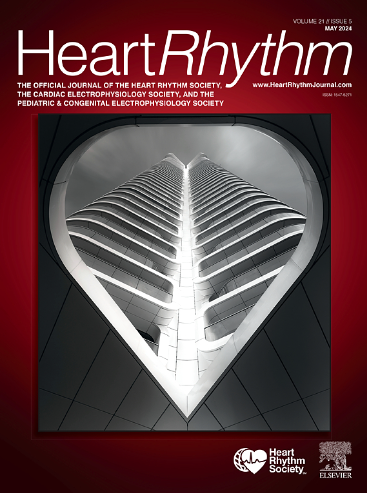处理心脏植入式电子设备导联患者的 SVC 综合征:策略和注意事项。
IF 5.6
2区 医学
Q1 CARDIAC & CARDIOVASCULAR SYSTEMS
引用次数: 0
摘要
背景:有关经静脉(TV)导联引起的上腔静脉(SVC)综合征的数据十分有限。处理这一问题可能需要采用多学科方法,通常包括拔除电视导联(TLE),然后进行血管成形术和支架植入术:目的:描述电视导联相关 SVC 综合征的处理方法和结果 方法:我们回顾性地识别了 2015 年至 2023 年期间埃默里医疗中心诊断为 SVC 综合征和电视导联的患者:结果:共发现15例导联相关SVC综合征患者。群组平均年龄为 50 岁。症状包括面部、颈部和上肢肿胀(67%)、气短(53%)和头晕(40%)。患者平均有 2 ± 0.7 条导联穿过 SVC,导联停留时间为 9.8 ± 7.5 年。13 名患者接受了经静脉导联取出术(TLE),随后进行了 SVC 支架植入术和血管成形术(10 名),或仅进行了血管成形术(2 名),还有一名患者在 TLE 后未进行干预。一名患者接受了抗凝治疗,另一名患者接受了血管成形术和支架植入术,并进行了铅固定。一名患者在进行SVC支架植入术时出现SVC穿孔和心脏填塞,经覆盖支架和心包穿刺术后成功治愈。在 12 位接受血管成形术和支架植入术的 TLE 患者中,有 7 位接受了经静脉导联的再植入术。其中两名患者的症状复发,而未进行导联再植入的 5 名患者中没有一人症状复发:结论:与导联相关的 SVC 综合征的治疗需要采用多学科方法,通常包括 TLE,然后进行血管成形术和支架植入术。避免再次植入电视导联可能有助于减少症状复发。本文章由计算机程序翻译,如有差异,请以英文原文为准。
Managing superior vena cava syndrome in patients with cardiac implantable electronic device leads: Strategies and considerations
Background
Data on transvenous (TV) lead–associated superior vena cava (SVC) syndrome are limited. The management of this problem might require a multidisciplinary approach, often involving transvenous lead extraction (TLE) followed by angioplasty and stenting.
Objective
The purpose of this study was to describe the management and outcome of TV lead–associated SVC syndrome.
Methods
We retrospectively identified patients with a diagnosis of SVC syndrome and TV leads at Emory Healthcare between 2015 and 2023.
Results
Fifteen patients with lead-related SVC syndrome were identified. The cohort average age was 50 years. Symptoms included swelling of the face, neck, and upper extremities (67%); shortness of breath (53%); and lightheadedness (40%). Patients had an average of 2 ± 0.7 leads crossing the SVC, with a lead dwell time of 9.8 ± 7.5 years. Thirteen patients were managed with TLE, followed by SVC stenting and angioplasty in 10 and angioplasty alone in 2; 1 patient had no intervention after TLE. One patient was managed with anticoagulation, and another had angioplasty and stenting with lead jailing. One patient experienced SVC perforation and cardiac tamponade during SVC stenting, which was managed successfully with a covered stent and pericardiocentesis. Among the 12 patients with TLE and angioplasty ± stenting, 7 underwent reimplantation of a transvenous lead. Two of those patients had symptoms recurrence, and none of the 5 patients without lead reimplantation had recurrence of symptoms.
Conclusion
Lead-related SVC syndrome management requires a multidisciplinary approach often including TLE followed by angioplasty and stenting. Avoiding TV lead reimplantation might help reduce symptoms recurrence.
求助全文
通过发布文献求助,成功后即可免费获取论文全文。
去求助
来源期刊

Heart rhythm
医学-心血管系统
CiteScore
10.50
自引率
5.50%
发文量
1465
审稿时长
24 days
期刊介绍:
HeartRhythm, the official Journal of the Heart Rhythm Society and the Cardiac Electrophysiology Society, is a unique journal for fundamental discovery and clinical applicability.
HeartRhythm integrates the entire cardiac electrophysiology (EP) community from basic and clinical academic researchers, private practitioners, engineers, allied professionals, industry, and trainees, all of whom are vital and interdependent members of our EP community.
The Heart Rhythm Society is the international leader in science, education, and advocacy for cardiac arrhythmia professionals and patients, and the primary information resource on heart rhythm disorders. Its mission is to improve the care of patients by promoting research, education, and optimal health care policies and standards.
 求助内容:
求助内容: 应助结果提醒方式:
应助结果提醒方式:


